This is the final version of for my 491 final. New additions include:
– 4 more endings
– New introduction title cards
– New name (was “Keyboard and Mouse” and is now “The Keyboard & The Mouse”)
– Thumbnails are all now just the word on a black background as to not spoil the choices leaving audiences more curious
This project utilizes:
– Networked Video (Using the YouTube Platform)
– Looped Video (See the “Delete” ending)
– Montage Video (See the “Italics” video)
https://www.youtube.com/watch?v=pLA6co19N0k
I will be releasing this video to my YouTube channel soon just as another experimental work. I am decently pleased with it compared to my last “choose your own adventure” work, but I know there is more to be learned… I will make another choose your own adventure work again.
-Rylan Eisenhauer
Author: Rylan Eisenhauer
Rylan Eisenhauer DTC491 Final Project Rough Cut
This is a chose your own adventure style work that is hosted on the platform YouTube. it is a 12 video experience but only 8 have been made for the rough cut. There will be 5 endings but currently only 1 is available in the rough cut, all “Option Unavailable” sections are for the 4 other endings that still need to be created.
The techniques from the class I utilize in this project are “networked video”, “montage” (during the Italics video), and “looped video” (not featured in the rough cut and will be one of the endings)
https://youtu.be/FZvfTiKl47s
I hope you enjoy this work as I am excited to finish it up!
Rylan Eisenhauer DTC491 HTML Video Project
https://dtc-wsuv.org/reisenhauer24/cinema/
Rylan Eisenhauer Plog Post #9 “Final Project Idea”
I have thought for a while on what I would like to do for my final project and I want to do something somewhat experimental and share where the inspiration came from.
The two modules I will be using for this video project are networked video on YouTube and Looped video.
My idea for my final project is to make a “choose your own adventure” using the networked video platform YouTube of what would be a screen recording of a Google doc as a man is trying to write a love letter. The interactivity aspect will be that the audience can choose to help or mess with the guy’s writing by changing the font, the color, deleting his work, and more by using the mouse. I will also be utilizing loops in order to convey longer extended time and even reputation to show a back and forth or fighting between the text and the mouse. I want the man to speak to the audience specifically through typing to “speak” to the audience by typing “you better stop that! its very frustrating!” The audience will be able to “communicate” by being almost a “silent character” only able to convey what it is doing using the mouse doing actions like pointing, moving around the screen, and things like that.
The endings I have in mind for now are a good ending where the audience helps the guy and things are happy, a bad where they guy gets fed up and just leaves the audience to watch the blank empty doc as the mouse just moves around in a loop, and many another where they get in a fight of control over the mouse to also use some loops.
I am still working to figure out how many videos will be encompassed in this video, but I want it to feel engaging, have a sense of comedy to it and use music to help convey the emotionality and tone of the work. The inspiration for this idea is similar to the “Animation Vs Animator” series but instead of an animation or stick figure, its just the mouse and text that appears on screen. It will be less “cinematic” and wont be as advanced, but I think there is a fun story that I can tell with this medium and utilizing interactivity with it would be lots of fun.
Rylan Eisenhauer Blog Post #8 “Bill Viola”
Bill Viola give a pretty close speculation of the more creative reorganization of presenting film we have been seeing in today’s society. He relates ideas of our own self development through self reflection similarly to how we may turn to the film we capture and rethink its purpose or arrangement. The greatest connection he drives is “Today, development of self must precede development of the technology or we will go nowhere—there will be condominiums in data space (it has already begun with cable TV)”(Viola pg. 14). And in the case of Bandersnatch taking the idea of a choose your own adventure with the intention of finding multiple paths and routes to explore, it itself is a reflection of the condominiums in how we can change the approach we take to engaging in observing and consuming film.
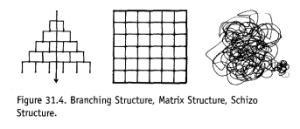
The way we structure our films are important as it will ensure audiences has a comfortable and entertaining experience so they can have as many take always as possible. This is what leads us to favor the approach of very linear storytelling as its easiest to consume and present information. However, in cases like Bandersnatch and other choose your own adventure stories, it almost makes the goal or message of the film to encourage the non linearity and loops as a reflection of the very choices we make seeming more impactful when we know the array of choices we could witness. We have been at odds with how we can present these ideas without audiences feeling too taken aback or confused as stated “artists know that there must be more out there than this. Even though the technology is interactive, this is still the same old linear logic system in a new bottle”(Viola pg 11)
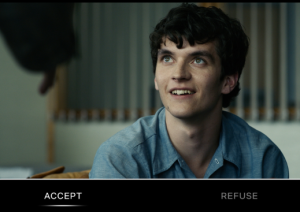
Bandersnatch is similar to this as although it encourages going back and forward to find other routes, thats still linearly moving forward and back. Only rarely do we see a flashback of his childhood and it being primed so that the audiences is guided to that instance and put right back where they left off. It is for this reason I still find Bandersnatch entertaining rather than tedious from a viewer perspective. But that doesn’t mean I still think that linearity is the only way we can or should go about creating film works. Its for this very reason I give praise to Kaleidoscope on Netflix as its whole purpose is to an arrange a random order for people to view and then experience to find out the big picture. Its like putting a puzzle together, there isn’t a correct place to start, you just slowly start connecting ideas until you get the full picture.
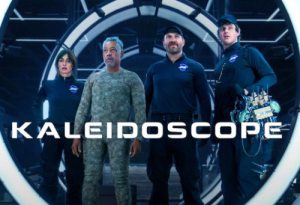
I believe that aiming towards more creative ways of compiling footage and unique storytelling is a direction we are headed that can point to new possibilities for viewers. But as of right now we are in a place of worrying that if we embrace too much interactivity and non linearity, we are at risk of viewers being overwhelmed with choice and thinking that the ideas presented are to disjointed. Not to mention with attention spans getting lower and lower overtime, if things aren’t interesting or apparent right off the bat, people will just lose interest. We as people still crave structure and organization, thus “visual diagrams of data structures already being used to
describe the patterns of information on the computer video disc. The most common one is called “branching,” a term borrowed from computer science”(Viola pg. 11). And as we work with film, we know the linearity of time always moving forward, even if you play footage in reverse, the time on the video will still always count forward. We have rules we need to abide by while working to creatively bend them.
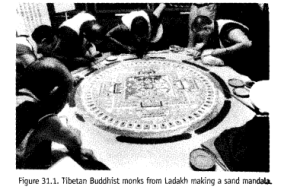
Viola also made a point to draw connections to sacred art (as seen above) that works to challenge the simplicity of the choose your own adventure approach as a nonlinear form of storytelling. Within the image shows a Japanese shaman called itako that which calls upon spirits to communicate with them. This form of communication “without the aid of wires or hardware of any sort, have been for ages regularly communicating through time and space with ancestors long gone”(Viola pg. 4). They encouraged the mapping of space in the mind known as “the walk through Hell” to bring spirits along towards familiar paths. Sacred arts like these transport what would be a “viewer” to go across space and time through the mindscape in order to experience something non linearly. The choice of going down the path is so vast in one being to stay right where you are and the other to go what would be to a different world in a single decision.
It is my believe that the technologies we are working with to increase interactivity will become more advanced in time, but we are still in the early day basics. We as a culture are not yet at the place of suspending disbelief as easily if it doesn’t follow the rules we are familiar with (abiding by space and time linearly). But this doesn’t mean we haven’t been trying or working to break this mold. electronic literature writers have been working to create non linear works through key words and multimedia methods of creating experiences that often seem disjointed. If we are able to apply the puzzle framework to viewers to challenge them to witness more thought provoking ideas, we could see the age that advance storytelling methods like these are normalized and can be more personal and investing experiences.
-Rylan Eisenhauer
Rylan Eisenhauer 491 1-3min Video Essay Assignment
Rylan Eisenhauer Blog Post #7 (30-60 sec Video Essay)
For my 30-60 second video essay, I chose to talk about Red Robin as it is my all time favorite burger place and where I spent many birthdays and gatherings.
This restaurant holds a special place in my heart and I am glad I was able to collect so many images and videos of my experiences and events to showcase how much I appreciate what this place represents in my life.
Rylan Eisenhauer Blog Post #6 (Video Essay Films)
Video essays have always interested me as they have always been able to showcase a persons passion or interested in a topic that a paper or written work cant do full justice. Especially if the video essay creator uses themselves as the person to explain the topic and all of their thoughts in a creative way. Specifically, the video essay and more so creator of it I would like to showcase is Scott The Woz on YouTube and his “Not for Resale” video essay:
Scott’s video essay doesn’t take the exact formal approach most do, he understands that comedy through quick whiplash bits and segments keeps people engaged while able to inform the audience of more information that can be used for another bit/segment. This language is perfect for nerd type audiences and those who are curious about video game topics to both be informed and entertained. He is able to keep a semi professional tone about the topic while being free to put emphasis and swearing about segments he has stronger beliefs about which may resonate with the audience too.
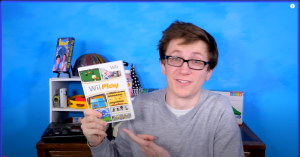
The usage of imagery is really well done as he uses video gameplay for the segments he is informing people about and uses imagery on top of that to visually point out key components. Meanwhile, he reserves showing his face specifically for bits and comedy so that it is clear to the audience what they may expect. This reminded me of the F is for Fake video talking about “meanwhile back on the ranch” as when he is done talking about the logistics of a topic, he rounds it off with comedy as a segway into the next section.

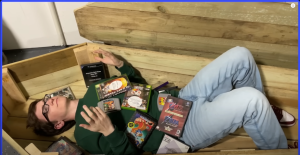
His consistency of theming all ties into one another really well to even be using video game music in the background for the majority of the video, even cutting the music out during a punchline to extenuate the impact of the joke. The visuals and the audio tie into each other so well because Scott understands that with his style of comedy that timing is key. Every pause, whiplash, cutaway, and visual on screen helps to keep the audience either informed or comedically entertained. Thus he stays true to the points from How YouTube Changed The Essay by Evan Puschak by being a “Short Interesting Truth.”
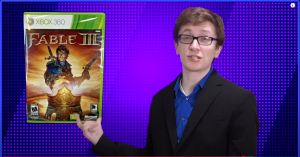
So how would I go about writing my own video essay? Well the two key points I took away from the videos that I want to keep in min while writing is the goal in mind and its execution. The goal should be to keep whatever topic I think of to be short, interesting and truthful at heart. Even if the essay takes a bit more of a stance or opinion, it still needs to be factual information, brief yet informative, and have a gimmick or way of keeping audiences interesting. Which I believe can be obtained as long as I stay true to the execution of being causal using “therefore,” “but,” and “meanwhile” to connect all of the topic and points together in a linear fashion. As for how I actually write down the pacing and structure, I should look into a two column structure or at very least be descriptive in what visuals and audio are happening when as voice over and visual cues will be necessary.
-Rylan Eisenhauer
Rylan Eisenhauer DTC 491 “AI Video Project”
This video really tested my patience in both getting runway to create what I needed. The videos it spat out always had the issue of moving the camera by zooming in a lot when I wanted it to be mostly stationary despite checking the stationary camera box (cause if I check that, the woman does not move at all).
The lip syncing part was pretty start forward and fun, I used character.ai in order to get a female voice that matches to the AI woman, I actually like the fact that she sounds a bit robotic as it automatically creates the feeling of things being fake and not creating a connection for the man.
Lastly, getting the video down to 1 minute (1:08) was a genuine challenge, putting in all of the video I captured I had 8 minutes, my first edit down was 3 minutes, then 2, then 1:30. I finally got it down to 1:08 and knew that if I cut anymore, it would impact the story of the video.
Here are some screenshots of the work that went into creating this video and the AI prompting for getting the images, videos, and even the AI voice using character ai:
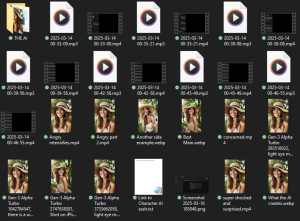
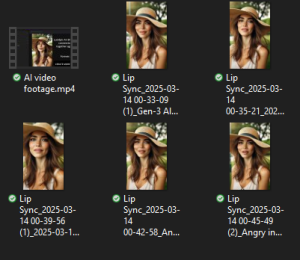
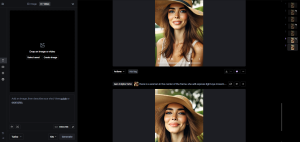
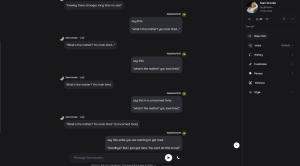
Rylan Eisenhauer Blog Post #5 (Chat GPT Video Part 2 Shots)
This is the second part of my ChatGPT conversations and composition of my AI Video project. For more early conception ideas refer to “Rylan Eisenhauer Blog Post #4 (Chat GPT Video Chat)”. This post is about the specifics in narrowing down the shots I want to create for the project using ChatGPT to edit and narrow down my ideas. Below is a screenshot of my finalized list of shots and expressed emotions that I am aiming for, and below that is the entire conversation I had with ChatGPT to edit and narrow down my ideas:

Since the video work I am creating consists of sad and slow shots, I should only have about 7-8 shots as I think the drawing out of scenes and panning shots can help extenuate the feeling of things being slow and gloomy. Too many fast and whippy shots can ruin the effect I am going for as well as give the audience “too much” information when things should feel a bit ambiguous so that many can relate their experience to my video.
I was recommended to try and practice using RunwayML a little bit in order to experiment with AI creating video. I knew exactly what I wanted to test as I have had a still graphic of a lens flare that I wanted to give some motion. I gave RunwayML the image with the prompt:
“the yellow/orange flare in the middle does not move from the middle, but the rays that it shines slowly shine outwards without covering the red background. The video should end looking how it started as if it loops.”
Here is the still image as well as the video it gave to me as a result of the prompt, it was almost exactly what I was looking for besides the loop part:

This is exactly as I was looking for and I am glad it seems I understand that being specific with prompting is important. I will ensure to keep this strongly in mind when making my AI video and ensure that there is a strong sense of consistency in the videos as well as characters (such as the female AI character) looks consistent and natural.
-Rylan Eisenhauer
Rylan Eisenhauer Blog Post #4 (Chat GPT Video Chat)
When first starting my dialogue with ChatGPT I realized how important wording my prompts was. My first ask was involved saying how I was gonna use AI to create video but ChatGPT read that as “give me ideas that would make videos about AI.”
I ended up using the prompt “give me some ideas for some short film projects/ story ideas” which definitely helped get more on the right track with creative endeavors. ChatGPT gave me 10 ideas. The 3 I liked most were “Fading Memories,” “The Last Passenger,” and “Echoes of the Past.” I decided to expand upon “Fading Memories” as it seemed a route that would work well with AI being almost a dreamlike state where what is generated is allowed to be a bit odd because it may not be remembered correctly.
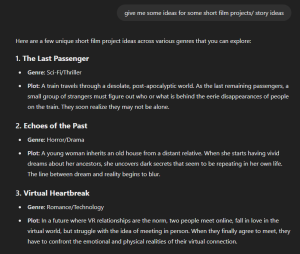
I expanded on this idea with the prompt “Hey I like that “Fading Memories” idea! I want to do a 30-60 second short film montage with me having dialogue over assortment of hazy memories. what types of shots should I consider for this project?” to which it gave many ideas that I liked with having a mixture of shorts both of the past memories being hazy and close up dramatic slow shots to create a similarity and contrast of sad feelings between both shot types.
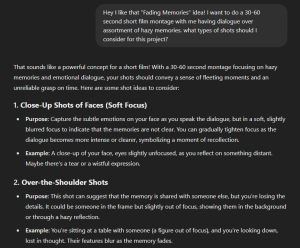
Thus I have landed on the idea to make a dramatic 30-60 second short film of happy memories slowly fading as they have happened so long ago. I will most likely make it about a love relationship that has been lost to time and being separated has made the emotion of the memories feel bittersweet. I want to have myself do the dialogue, record myself as the character in the non memories section and then use AI for all of the hazy dream sections.
To compare what I am envisioning to other works of film and quality type, the lighting of the shots of the man alone with be very dark and the AI memories will be black and white to show a positive yet slightly forgetfulness. The set for the alone man will be places like sitting on the bed, looking in the mirror, and other dramatic dark locations with the lights off meanwhile the shots of AI will be more outside and open with sunlight or good indoor lighting.
The AI creations will be similar to the montage we see at the beginning of Up (except not cartoon looking and using black and white instead) I see why they have the color in Up as Carl’s memory is fine and stable, but for my effect I need things to not have all of the details like a part of you is trying to keep it and the other wants to throw it away.

(But black and white with hazy effects)
Another point to draw from is the film “A Man Called Otto” which I believe shows both how I want to shot the in real life shots similar to Otto in his home being dramatized with different close ups and establishing shots, but also how the hazy memories are done in the montage style(except black and white instead of yellow) The yellow of these shots show pure untainted happiness about those memories meanwhile I believe the black and white effect will help show the sadness that has been added to the memories.
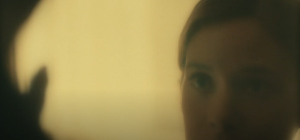
(But black and white)
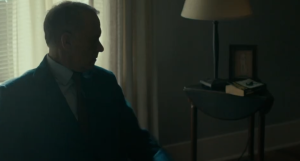
(Darker lighting but similar vibes of this)
-Rylan Eisenhauer
Rylan Eisenhauer DTC 491 Loops All 3 Videos
Here are my loop videos for the Loops Assignment. each one repeats 3 times
Continuity Loop (7 secs)x3:
Infinite Loop (8.6 secs)x3:
Montage Loop (6.3 secs)x3: (No Sound)
-Rylan Eisenhauer
Rylan and Lyndsey Montage in class video
Rylan Eisnehauer DTC491 Breaking Space Video
The breaking space style I went for was using the Metric montage style with every video being exactly 3 seconds long. the Metric style ensures that editing follows a specific number of frames, duration of shot. This gives the montage a light rhythmic visualization while the near silent ambience of the room helps create the calm and relaxed vibe.
The calm and relaxing vibe I aimed towards was filming all of the different features and décor that is within my recording room. There is no sound besides light whirring of fans and brushing up against its elements to convey the importance of the items creating their own visual experience of the room. The room has many objects from posters, plushies, and gaming equipment to showcase the variety of interests while also showing the liveliness of the room also depends on the energy its given. When the main overhead light is off but the LED’s are on, you get a sense of motion and living from all of the motionless objects.
Rylan Eisenhauer Blog Prompt #3 (Time Frames, by Scott McCloud)
Right off the bat, McCloud gives the reader strong examples of how our focus on the frame and the properties it holds helps the viewer fill in blanks and create a sense of time when reading multiple parts of dialogue in a single frame. Time doesn’t stay consistent specifically based on singular properties of a frame. Rather, it is comprised of the sizing of the frame, how much dialogue, what is being captured in the frame, and even the detailing often having the audience spend more time looking at the quality of the art to imply impact.
Take for example the first example McCloud gives that involves a wide spread of characters speaking but there is a series of events and timing that helps create a sense of flow. Starting on the left the man takes a picture, the guy who gets his picture taken reacts, due to that reaction a women discourages the picture taker, then another women responds to her saying that he is fine doing so, then a man responds to the fact that he is being encouraged and encourages other behavior, and lastly the man on the right acknowledges his remarks and encourages as well.
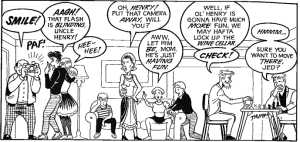
When first looking at this scene, my first initial thought is that all of these pieces of dialogue happen at the same time, because visually they ARE being presented at the same time. But it’s because of the content of what they are saying and who they are speaking to that creates a order of operations rather than a chaotic “everyone is speaking at the same time.” So now we have gotten a sense of space where everyone is and established interactions with one another as a quick judge of character. What was done in one frame is a shot that would most likely last around 15-20 seconds panning from character to character as the audience focuses on the next person.
The best connection that McCloud makes is how the rope being stranded from one dialogue bubble to the next. We can see that the flow of the events have to happen in a certain order otherwise the dialogue they provide wouldn’t match up with a different character such as one character saying “Oh Henry, put that camera away will you?” and the next saying “hmmmm, you sure you want to move there Jed?” It just doesn’t make sense!
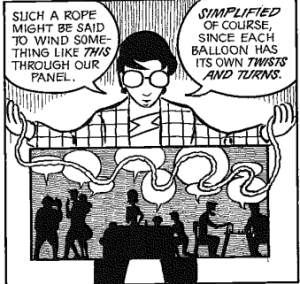
The other point McCloud made that stuck out to me is the frame shaping and its placement with the other frames. We in our culture read from left to right top to bottom so following this flow is pretty important, but that doesn’t mean we are completely restricted to this or how these frame are expressed individually or in a sequence. Some frames use 2 frames overlayed to often emphasis a certain aspect of a frame such as a zoom in or extra dialogue that happens within the same scene. These overlay frames can be place almost anywhere overtop as long as the writer can express what is happening in the background frame in relation to the one overtop.

Last point I want to talk about is panel sizing and framing within the shot size. Frame sizing often implies stronger importance on frames that are bigger when there are more details or aspects that the author wants the reader to pick up on. This is best explained in the “I guess” comic McCloud refers to, as it helps us create a sense of time between first dialogue and the next. Looking at the 2 examples below:

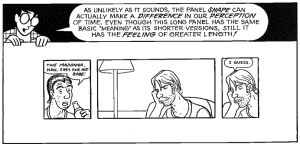
The first example shows a moment of thought, its brief but still exists within the timeline. But look at the size and framing of the second example, it shows deeper more well thought out thinking, they even make him a bit smaller in the scene so that both himself and the shot have gained new perspective. Not to mention that the frame zooming back in also creates a sense of impact to admitting the “I guess” to show that he put more thought into it verses the first example.
-Rylan Eisenhauer
consider the framed panel in a comic as a cinema shot. Wider or longer panels are like shots with longer durations (“long takes”). Smaller panels are like shots of shorter durations. Discuss some aspect of McCloud’s visual essay that makes you think of the possibilities of time manipulation in digital cinema or of a certain movie scene that plays with time.